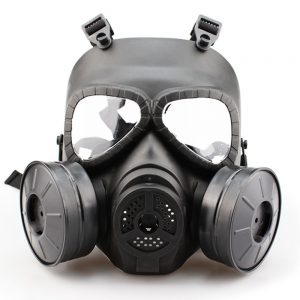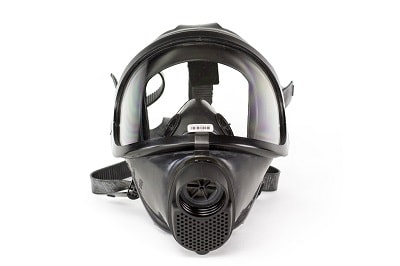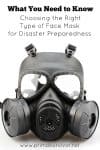One of the most commonly overlooked survival gear items is a face mask. The purpose of the face mask is to protect you from inhaling harmful airborne substances.
Depending on the situation, these airborne substances could be viruses, asbestos, volcanic dust, or chemicals from a terrorist attack.
If you doubt the need for a face mask, look at virtually any disaster in recent times.
The terrorist attack of 9/11, for example, resulted in thousands of additional deaths because of the asbestos and other toxins which were inhaled.
In the aftermath of Hurricane Sandy, people were also exposed to toxic construction materials and mold.
And the earthquake in Japan damaged a nuclear power plant and caused many people to be exposed. These are just some situations where you’d want a face mask!
Many people incorrectly assume that a gas mask is the best choice for disaster preparedness. In a chemical attack, a gas mask would be your only protection. However, a gas mask isn’t the only option — and it isn’t always the best option.
Here we will go over the 4 main types of face masks for disaster preparedness so you can choose the right type for the disasters you are prepping for.
Dust Masks
Dust masks are cheap and are held over your mouth with a plastic strap.

These are only suitable for keeping out large non-toxic particulates.
For example, you might wear a dust mask when mowing the lawn or cleaning your dusty attic.
Under no circumstances should you rely on a dust mask for survival. However, a dust mask is better than nothing if you don’t have anything else.
Key Points
- Cheap and readily available
- Protect wearer from dust
- Not suitable for most disasters, but better than nothing
Disposable Particulate Respirators
There is a lot of confusion about disposable particulate respirators, mainly because they resemble dust and surgical masks.
Particulate Respirator vs. Dust Mask
A particulate respirator protects against hazardous particulates in the air. A dust mask does not.
Respirator vs. Surgical Mask
Surgical masks protect the environment from the wearer. For example, a surgeon would wear a surgical mask to stop the patient from getting contaminated by germs in their breath. By contrast, particulate respirators protect the wearer from the environment.
Types of Particulate Respirators
The most common type of disposable particulate respirator for survival use is the N95 mask.
Because these are very effective in filtering out most hazardous substances (filter at least 95% of particulates to 0.3 microns), are cheap to buy, and easy to wear, these are probably your best choice for emergency preparedness.
Only buy a particulate respirator that NIOSH has approved! Or you could get a mask that meets European standards. These masks carry the EN-149 label.
Note that particulate respirators are useless against gas and chemicals. You would need a chemical or vapor mask for that level of protection.
You can read all about N95 face masks here.
Key Points
- Relatively cheap and readily available
- The rating matters! Choose at least an N95 rating
- Make sure NIOSH has approved the particulate respirator
- Do not protect against chemicals or vapors
Reusable Particulate Respirators
These masks look like gas masks because they cover more of your face.
However, just like with the disposable particulate respirators, these are useless against gas and chemicals.
Some higher-quality respirators can filter out gases and vapors at a “nuisance” level but won’t provide any real protection.
The term “reusable” can be confusing.
Only the mask part of the respirator is reusable. For it to remain effective, you will have to replace the filters.
Depending on the type of mask, the filters might pop on, get screwed on, or have to be inserted.
Advantages of Reusable Particulate Respirators
Even though reusable particulate respirators aren’t necessarily more effective than disposable ones, they have advantages.
The main advantage is that these can be fit much more securely than a disposable respirator. Getting the right fit is crucial for preventing air leakage, so this advantage shouldn’t be dismissed!
The reusable particulate respirators also have vents for exhalation. This makes them much more comfortable to wear and prevents the mask from going in/out on the face.
Reusable particulate respirators come in half and full-face masks. It is usually better to opt for the full-face mask. While these limit your field of vision (and make you stand out in a crowd), they protect your eyes and skin from particulates.
Key Points
- Protects against particulates
- Full-face masks will protect your eyes and skin
- Must replace the cartridges!
- Does not protect against chemicals or vapors
Gas and Vapor Masks
These are half or full-face respirators with special cartridges attached to them.
The cartridge contains a material that captures chemicals or gases from the air. The material is often activated carbon, but other materials may be used too.
Mirasafety.com have a substantial range of NIOSH-approved chemical, nuclear and tactical masks and cartridges.
They also offer free US shipping, 30-day returns, and a 5-year warranty on their products.
Read our guide to the best gas mask for the average prepper.

See Full Range
Not all gas mask cartridges are capable of catching every type of hazard. NIOSH uses a color-coding system for cartridges based on what they catch.
| Color | Filters |
|---|---|
| Black | Organic vapors |
| White | Acid gases |
| Yellow | Organic vapors/acid gasses |
| Green | Ammonia/Methylamine |
| Olive and Black | Formaldehyde/organic vapor |
| Olive | Multi-gas/vapor |
| Orange | Mercury vapor/chlorine gas |
Buying Gas Mask Cartridges
Buying a gas mask cartridge can be confusing since you won’t know what threat you are facing.
To make things even more confusing, gas cartridges do not filter out particulates! For example, a gas mask cartridge with an Olive color would protect you from ammonia but wouldn’t necessarily protect you from asbestos in the air.
Thus, for the best protection, you’d need to get a mask with a combination cartridge for gas and particulates or a mask with a particulate pre-filter and a gas cartridge.
Gas Mask Cartridge Costs and Life Span
Even though they are the most effective, gas masks aren’t always the best choice.
The main issue is that they are expensive to buy. The cartridges I’ve looked at range from $10 to $25 each.
Even if you can afford the initial cost, be aware that the cartridges have a shelf life. This can range from 3 years to 20 years depending on the supplier. We recommend sticking with a known supplier such as Mira Safety as they clearly label the shelf life of their products.
Once you start using a cartridge, it doesn’t last very long. As the CDC writes, how long the cartridge remains effective varies depending on the air quality. For example, in a severe SHTF situation, a cartridge might only last for an hour before it needs replacing. Even when you are just breathing in fresh air, the cartridge might last just 24 hours.
When the chemical cartridge becomes fully saturated, the trapped chemicals will then be transferred to the user.
Because of the cost issue, many people buy used military surplus gas masks. This is NOT advisable!
Many of those old gas masks don’t work efficiently, and it can be hard to find cartridges that fit. And don’t buy old cartridges as they will have expired!
Key Points
- Cartridges have a shelf life and need to be replaced (usually about 5 years)
- Once in use, the cartridge will need to be quickly changed – especially if the air is very tainted
- The cost of cartridges will quickly add up!
- Not all cartridges protect against all chemicals/vapors
- Cartridges do NOT filter out particulates!
- For best protection, you’ll need a gas mask with a pre-filter or a combination cartridge
Do you have a face mask in with your emergency supplies? Which one? We’d love to hear from you in the comments.





Ok so …. What kind of mask SHOULD one put in their prep to protect against chemical / vapors / gases / radioactive whatchamacallits?
Because in my extremely limited understanding (meaning this is the first and only time I’ve read about the various mask types and when / how / if to prep them) I deduced I should get a quality P100 mask for general use and a proper gas mask for the heavy duty encounters.
Did I miss the mark there? (Trying to keep this budget friendly too as I have to get masks for six people – hubby and I and four small children to purchase for as well).
Any advice for me?
And when it comes to nuclear – should we bother to protect against it? Would there be anything left behind worth living for anyway? We live extremely close to the only nuclear power plant in my state, and it’s about the 15th largest in America. Somehow I have my doubts if it blows up along with whatever bombs are potentially dropped (hypothetically speaking of course) that it won’t be survivable for us, and even if we could, would we want to? Even with our best efforts would we prep and stay healthy and alive for 6 months? A year? Just to then starve to death once supplies run out because everything will be toxic?
There’s no real way to get total respiratory protection on a budget. Gas mask cartridges expire, so you have to replace them somewhat frequently. The best solution IMO is to have a really good bug out plan in place and be ready to go immediately. I personally don’t do much prep against nuclear because it would be too expensive and unfeasable. But I also don’t live anywhere near a nuclear facility. If I was, then that would be a different story!
Hi I’m just trying to find the best masks to wear in case of a volcanic eruption or extreme smoke in the air? We live in the Pacific Northwest. Also I’ve had trouble finding masks for children under 10…
I’m about to write a post which will cover all of that. In your case, you’ll also need some goggles…
1) No mask will protect you unless it FITS… Facial hair in particular prevents an adequate seal to the face. All faces are not the same either, so, one mask does NOT fit all people. If you can pass an irritant smoke test the mask only probably fits. A better test is a quantitative fit test administered by a reputable trained and certified provider. (If you are interested in finding one look for a Certified Industrial Hygienist CIH in the yellow pages. Many of them give classes and certification in the art of Respiratory Protection).
2) The color codes listed above are out of date and don’t include MAGENTA the code for radiological particulates. Note: this will NOT protect you from radioactive gases, eg, Radon, Tritium, and other normally gaseous compounds which may contain radioactive nuclides.
Nuff Said at least for now…
Do you have a pattern for a Hepa filter mask…or any maskk?
Yes see here for homemade respirator mask instructions with downloadable pattern.
“This one gets reasonable reviews.” The H… double filters full face is a China made mask (some are really professional and protects against very tough conditions, but you dont find them so easily). Good to know that the filters are specific to the brand, and you cnat find them if no stock, no internet, no fret, etc. Or model not yet sold. Two norms for safe prepping : 3M (bayonet type), and 40mm thread (the Western – Nato – chinese reference, not the ex soviet – russian one, only good fro cosplay or fancy). 40mm is far more tough for heavy duty conditions. Avoid any military specific new side filters references, they are v difficult to find as new and not obsolete !
Good info. Thanks Anita.
Good an realistic paper, which is not so common for the respiratory protection issue, with a lot of confusion even among “prepping” pages. the so called dust masks are now uncommon, due to labor health regulations elsewhere. You now nearly find the FFP1, 2, 3 labels, or N95, 99, 100, depending on the country (as a matter of fact, since the brands and plants are international, the same product can be rated N or FFP depending on the country). The issues with combined cartridges are another confusing thing. Surgical masks, even the PM2.5 rated, commonly distributed during ash, smoke or so events, are more or less useless if badly worn (most people), and not tight fit on the face by an extra layer of fabric.
Thank you for this informative article! You always have such good stuff!!
REQUEST: Is it possible you could do an article about the best kind of mask to get (And maybe suit) for a nuclear situation? (NBC)?
Thank you.
Hi John – we have an in-depth piece on nuclear survival here – https://www.primalsurvivor.net/nuclear-survival/